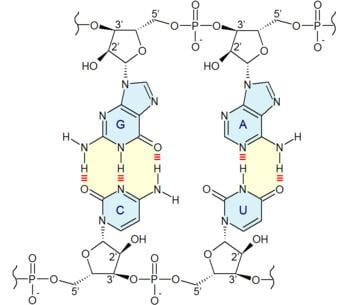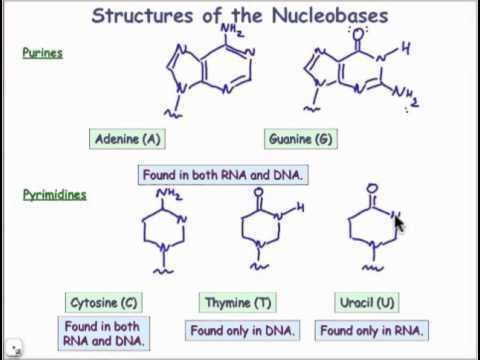 | ||
Structures of the nucleobases
Nucleobases are nitrogen-containing biological compounds that form nucleosides, which in turn are components of nucleotides; all which are monomers that are the basic building blocks of nucleic acids. Often simply called bases, as in the field of genetics, the ability of nucleobases to form base-pairs and to stack one upon another leads directly to long-chain helical structures such as ribonucleic acid (RNA) and deoxyribonucleic acid (DNA).
Contents
- Structures of the nucleobases
- Structure
- Modified nucleic acid bases
- Modified purine bases
- Modified pyrimidine bases
- Novel bases
- References

When a nucleobase forms a glycosidic bond (sugar bond) with a molecule of ribose or deoxyribose the compound is a nucleoside. A nucleoside joined to or more phosphate groups is a nucleotide. Nucleobases are also known a nitrogenous bases.

Use of the word base is historical, referring to the chemical properties of nucleobases in acid-base reactions, but the term is not especially important for understanding most of the biological functions of nucleobases.

The fused ring skeletal structure of adenine (A) and guanine (G) is derived of purine, hence the the name purine-bases; similarly, the simple ring structure of cytosine (S), uracil (U), and thymine (T) is derived of pyrimidine, hence the pyrimidine-bases. In a typical spiral-helix DNA, these bases arrange themselves into base pairs—that is, A pairs with T, and C pairs with G—that connect the two strands of the helix, analogous to rungs connecting the two sides of a ladder. The pairing of purines an pyrimidines may result, in part, from dimensional constraints—as this combination enables a geometry of constant width for the DNA spiral helix. The A-T and C-G pairings function to form double or triple hydrogen bonds between the amine and carbonyl groups on the complementary bases.

]8[ In August 2011, a report based on NASA studies of meteorites suggested that nucleobases such as adenine, guanine, xanthine, hypoxanthine, purine, 2,6-diaminopurine, and 6,8-diaminopurine may have formed in outer space as well as on earth.[1][2][3]
Structure
There are five primary, or canonical, nucleobases: adenine (A), cytosine (C), guanine (G), thymine (T), and uracil (U); they function as fundamental units of the genetic code. The so-called DNA-bases are A, G, C, and T: the RNA-bases are A, G, C, and U. Thymine and uracil are identical except for the lack of a methyl group in uracil. Biological bases that do not function as standard parts of the genetic code are termed non-primary, or non-canonical.
At the sides of nucleic acid structure, phosphate molecules successively connect the two sugar-rings of two adjacent nucleotide monomers, thereby creating a long chain biomolecule. These chain-joins of phosphates with sugars (ribose or deoxyribose) create the "backbone" strands for a single- or double helix biomolecule. In the double helix of DNA, the two strands are oriented chemically in opposite directions, which permits base pairing by providing complementarity between the two bases, and which is essential for replication of or transcription of the encoded information found in DNA.
Modified nucleic acid bases
DNA and RNA also contain other (non-primary) bases that have been modified after the nucleic acid chain has been formed. In DNA, the most common modified base is 5-methylcytosine (m5C). In RNA, there are many modified bases, including those contained in the nucleosides pseudouridine (Ψ), dihydrouridine (D), inosine (I), and 7-methylguanosine (m7G).[4][5]
Hypoxanthine and xanthine are two of the many bases created through mutagen presence, both of them through deamination (replacement of the amine-group with a carbonyl-group). Hypoxanthine is produced from adenine, xanthine from guanine., and uracil results from deamination of cytosine.
Modified purine bases
These are examples of modified adenosine or guanosine.
Modified pyrimidine bases
These are examples of modified cytosine, thymine or uridine.
Novel bases
A vast number of nucleobase analogues exist. The most common applications are used as fluorescent probes, either directly or indirectly, such as aminoallyl nucleotide, which are used to label cRNA or cDNA in microarrays. Several groups are working on alternative "extra" base pairs to extend the genetic code, such as isoguanine and isocytosine or the fluorescent 2-amino-6-(2-thienyl)purine and pyrrole-2-carbaldehyde.
In medicine, several nucleoside analogues are used as anticancer and antiviral agents. The viral polymerase incorporates these compounds with non-canonical bases. These compounds are activated in the cells by being converted into nucleotides; they are administered as nucleosides as charged nucleotides cannot easily cross cell membranes. At least one set of new base pairs has been announced as of May 2014.
